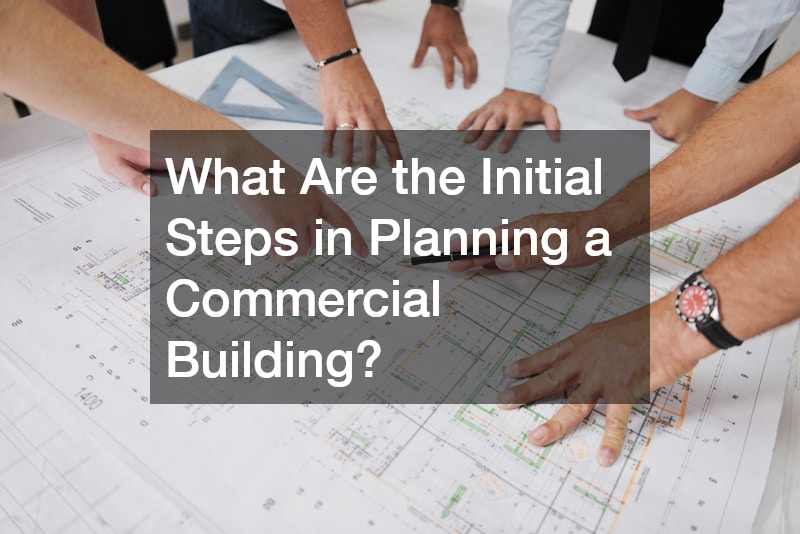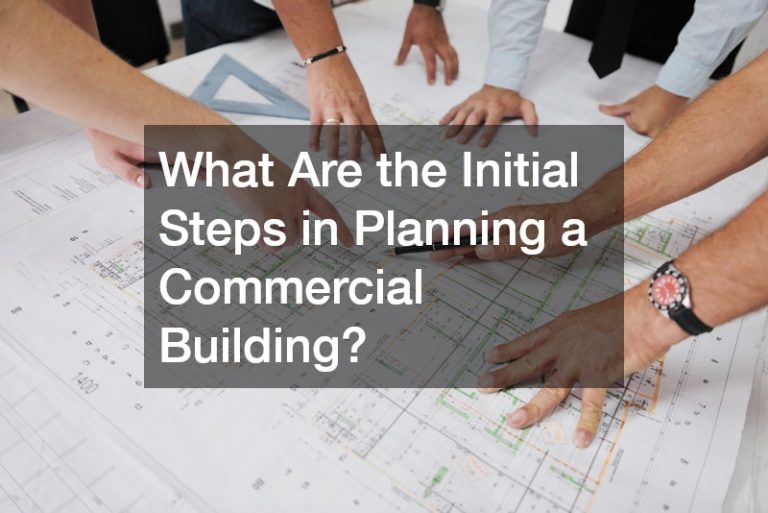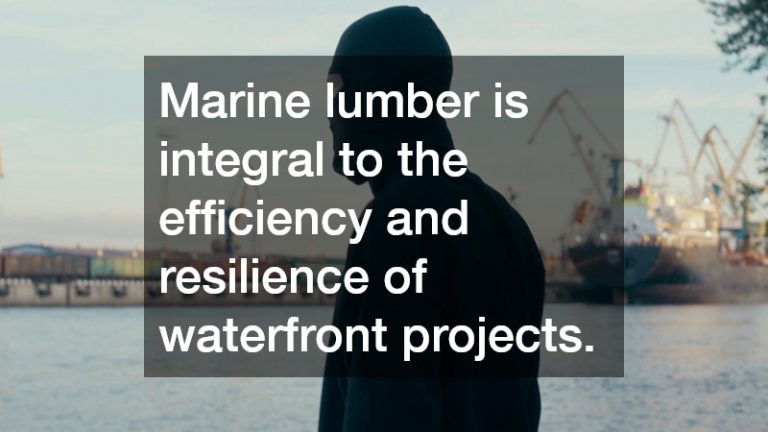Constructing a commercial building is one of the most significant investments a business can undertake. It requires careful planning, financial preparation, legal compliance, and thoughtful design. From selecting the right location to choosing materials and managing the construction process, every decision can affect the long-term success of the commercial property. This comprehensive guide explores the crucial aspects you should consider before beginning your commercial construction project, ensuring a smooth and efficient process from planning to completion.
What Are the Initial Steps in Planning a Commercial Building?
Before breaking ground, it is essential to lay a strong foundation through careful planning and assessment.
Conducting Feasibility Studies
Feasibility studies help determine whether the project is practical and financially viable. This analysis includes assessing market demand for the commercial property, evaluating potential revenue streams, and analyzing the condition of the site. Feasibility studies also identify potential challenges such as construction costs, zoning restrictions, and infrastructure limitations. A thorough feasibility study ensures that you make informed decisions from the outset, reducing the likelihood of costly delays.
Understanding Zoning Regulations
Zoning regulations define how a property can be used and influence building height, density, parking, and allowed functions. Compliance with these laws is essential to avoid legal disputes and fines. Understanding zoning restrictions is particularly important if your commercial building requires specialized features, such as large parking areas surfaced with asphalt, rooftop solar panels for businesses, or heavy-duty roofing systems like edpm roofing or commercial metal roofing.
Assembling a Professional Team
A successful commercial construction project requires a team of skilled professionals, including architects, engineers, contractors, and project managers. Each team member contributes expertise to design, compliance, and construction. Hiring professionals with experience in commercial property projects ensures that installations such as HVAC systems, plumbing contractor services, and commercial metal fabrications meet high standards and regulatory requirements.
Establishing a Budget
A realistic budget is critical for managing resources and avoiding financial setbacks. Budgeting should cover land acquisition, design and construction costs, permits, and a contingency fund for unexpected expenses. Including costs for specialized services, such as commercial metal roofer work, edpm roofing installation, asphalt paving, and water softener system integration, ensures that the project remains financially stable throughout its duration.
Creating a Project Timeline
Developing a comprehensive project timeline allows you to coordinate all phases of construction efficiently. A detailed schedule should include design approval, permit acquisition, site preparation, and construction milestones. Timelines help manage contractor schedules, including plumbing contractors, HVAC installers, and roofing teams, to prevent delays and ensure smooth progress.
How to Select the Right Location?
The location of your commercial property plays a significant role in its success. Choosing a strategic site enhances accessibility, operational efficiency, and long-term value.
Evaluating Accessibility
A commercial building should be easily accessible for employees, clients, and suppliers. Proximity to major roads, public transportation, and ample parking improves convenience and encourages business activity. Asphalt surfaces for parking lots and pathways should be considered to maximize safety and functionality.
Considering Demographics
Analyzing the local population helps ensure your commercial property meets market demand. Population density, income levels, and consumer behavior inform design choices, building size, and the type of services the property can accommodate. Demographic insights help align your building with community needs and long-term commercial potential.
Assessing Infrastructure
Adequate infrastructure, including water supply, sewage, electricity, and telecommunications, is essential for a fully functional commercial building. Certified sites with reliable utilities support installations such as solar for businesses, HVAC systems, and water softener systems. Ensuring the site can sustain these facilities prevents operational setbacks after construction is complete.
Analyzing Future Growth Potential
Future growth potential enhances property value and business opportunities. Areas with planned commercial or residential development provide prospects for increased foot traffic and expanded service demand. Choosing a site that allows for future expansion of asphalt surfaces, parking, or building additions helps maintain the property’s long-term relevance.
Understanding Environmental Impacts
Environmental assessments identify potential risks, including flood zones, soil stability issues, and protected ecosystems. Addressing these factors early ensures compliance with regulations and promotes sustainable building practices. Incorporating environmentally friendly roofing options like EDPM roofing or solar panels contributes to both compliance and long-term cost savings.
What Should Be Included in the Design Phase?

The design phase establishes the visual appeal, functionality, and safety of a commercial building.
Architectural Design
Architectural design defines the commercial property’s identity while accommodating operational needs. Architects consider both aesthetics and structural requirements, including specialized systems like commercial metal fabrications for roofing, roofing supports, or façade elements. A well-designed building balances form and function, providing a professional and inviting environment.
Ensuring Functional Layout
Functional layouts optimize workflow and space utilization. Proper planning ensures efficient circulation of staff and clients while accommodating utilities such as HVAC systems, plumbing infrastructure, and electrical conduits. Thoughtful design supports future adaptability, including expansions or new technology integrations.
Compliance with Building Codes
Building codes govern safety, structural integrity, fire protection, electrical systems, and mechanical installations. For commercial properties, compliance extends to specialized components such as commercial metal roofer installations and edpm roofing systems. Certified inspections and adherence to code requirements prevent legal issues and ensure the building meets high standards.
Sustainable Building Practices
Sustainability is increasingly important in modern commercial construction. Solar for businesses, energy-efficient HVAC systems, water softener systems, and sustainable roofing options reduce operational costs and environmental impact. Using responsibly sourced materials and incorporating green design principles enhances the property’s marketability and eligibility for green certifications.
Incorporating Technology
Technology integration improves building functionality and long-term efficiency. Smart HVAC systems, energy monitoring, plumbing automation, and roofing sensors help optimize operations and maintenance. Planning for these systems during the design phase ensures seamless installation and operation after construction.
How to Choose the Right Construction Materials?
Material selection impacts durability, cost, aesthetics, and sustainability.
Evaluating Durability
Durable materials, such as commercial metal fabrications for structural components and edpm roofing for weatherproofing, extend the lifespan of the building. Selecting robust materials minimizes repair needs and protects the property from environmental wear, ensuring long-term reliability.
Considering Cost-Effectiveness
While premium materials may require higher initial investment, they often save costs over time. Asphalt for parking and walkways, durable roofing systems, and water-efficient plumbing installations reduce maintenance expenses and operational disruptions.
Prioritizing Sustainability
Sustainable materials support environmental responsibility and reduce energy consumption. Solar for businesses, water softener systems, and responsibly sourced metals contribute to greener construction practices. Sustainability not only appeals to tenants but may also qualify the property for tax incentives and certifications.
Understanding Local Material Availability
Availability of local materials impacts construction timelines and costs. Working with suppliers of commercial metal fabrications, asphalt, and roofing materials ensures timely delivery and reduces logistical challenges. Locally sourced materials also support the regional economy and reduce the environmental footprint of transportation.
Assessing Aesthetic Value
The appearance of construction materials affects the commercial property’s attractiveness. Thoughtful selection of roofing, metal fabrications, and landscaping materials creates a professional, cohesive look that enhances the property’s curb appeal and tenant satisfaction.
What Are the Key Financial Considerations?
Financial planning is critical for the success of commercial construction projects.
Securing Financing
Obtaining financing is essential to cover the costs of land acquisition, design, construction, and specialized installations such as commercial metal roofer services, edpm roofing, HVAC systems, and plumbing contractor work. Clear financial planning demonstrates project viability to lenders and investors.
Estimating Construction Costs
Accurate cost estimates account for materials, labor, permits, and site preparation. Asphalt paving, commercial metal fabrications, roofing systems, HVAC installations, and plumbing contractor fees should all be included to prevent budget shortfalls.
Understanding Tax Implications
Tax planning ensures compliance and may identify potential deductions or incentives, especially for sustainable initiatives like solar for businesses or energy-efficient water softener systems. Awareness of tax implications aids long-term financial management.
Managing Cash Flow
Maintaining positive cash flow ensures construction progress without interruptions. Timely payments to contractors, suppliers, and specialized teams for roofing, HVAC, plumbing, and asphalt work prevent project delays.
Preparing for Unexpected Expenses
Contingency funds protect against unforeseen issues, such as delays, material shortages, or additional installations like commercial metal fabrications or emergency HVAC upgrades. Planning ahead minimizes disruptions and maintains project momentum.
How to Manage the Construction Process?
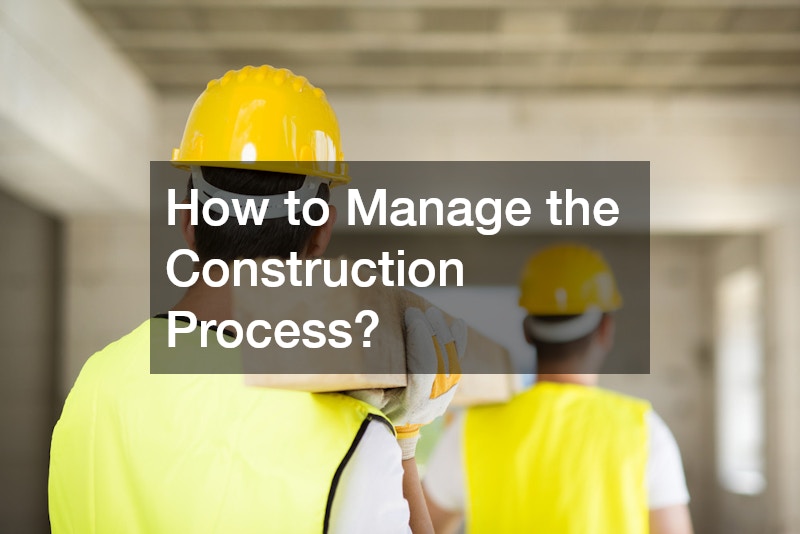
Effective management ensures timely completion and quality standards.
Hiring Reliable Contractors
Selecting experienced contractors, including commercial metal roofers, HVAC specialists, plumbing contractors, and asphalt paving teams, guarantees high-quality work. Contractor expertise directly impacts project efficiency, safety, and compliance.
Setting Clear Communication Channels
Maintaining open communication between architects, engineers, and contractors helps coordinate installations such as edpm roofing, commercial metal fabrications, and plumbing systems. Regular updates prevent miscommunication and maintain project cohesion.
Implementing Quality Control
Quality control measures, including inspections of roofing, HVAC, plumbing, and asphalt work, ensure compliance with design and safety standards. Documentation of inspections protects owners and contractors while supporting long-term building performance.
Ensuring Safety Standards
Construction safety is critical to protect workers and property. Proper installation of commercial roofing systems, HVAC units, and plumbing infrastructure must comply with safety regulations. Risk assessments and safety protocols minimize accidents and promote a secure work environment.
Monitoring Progress and Adjustments
Regularly monitoring construction progress allows for timely adjustments to schedules, materials, or contractor assignments. Tracking milestones, such as roofing completion, HVAC system installation, and asphalt paving, ensures the project stays on track.
What Are the Legal Requirements and Permits Needed?
Legal compliance protects your commercial property from fines, penalties, and construction delays.
Identifying Necessary Permits
Commercial construction requires multiple permits, including zoning approvals, building permits, environmental clearances, and specialized permits for HVAC, plumbing, and roofing installations. Acquiring these permits early prevents work stoppages.
Ensuring Compliance with Local Laws
Adherence to local laws ensures the property meets safety, accessibility, and environmental regulations. Compliance includes certified inspections for commercial metal roofer work, edpm roofing installations, and water softener system integration.
Understanding Liability Issues
Proper contracts, insurance, and risk assessments protect property owners from liability during construction. Coverage for specialized work, such as asphalt paving, HVAC installation, and commercial metal fabrications, safeguards against accidents or defects.
Contractual Agreements
Clear contracts with contractors and subcontractors define roles, responsibilities, timelines, and payment structures. Contracts for plumbing contractors, roofing teams, and HVAC specialists ensure accountability and project transparency.
Working with Legal Advisors
Engaging legal advisors helps navigate permits, zoning laws, contracts, and liability issues. Legal guidance ensures that all aspects of the commercial construction project comply with regulations and protect the owner’s interests.
How to Incorporate Green Building Practices?
Sustainable construction improves energy efficiency and reduces environmental impact.
Using Renewable Energy Sources
Solar for businesses provides renewable energy and long-term cost savings. Integrating solar panels into commercial properties reduces reliance on traditional power grids and supports sustainability goals.
Energy-Efficient Building Design
Energy-efficient HVAC systems, LED lighting, and insulated roofing systems like edpm roofing minimize energy consumption. Thoughtful design ensures that operational costs remain low while enhancing occupant comfort.
Sustainable Materials and Resources
Selecting recycled or responsibly sourced materials for commercial metal fabrications, asphalt, and interior finishes reduces environmental impact. Sustainable materials support green certifications and improve the building’s market value.
Waste Management and Recycling
Implementing a waste management plan during construction minimizes landfill use. Recycling metal roofing scraps, asphalt remnants, and packaging materials promotes responsible building practices.
Obtaining Green Certifications
Green building certifications demonstrate a commitment to sustainability and can enhance the property’s marketability. Certifications often consider solar for businesses, water softener systems, energy-efficient HVAC systems, and environmentally responsible materials.
How Do You Ensure Building Security and Safety?
Safety and security are essential for protecting occupants, assets, and operational continuity.
Designing Secure Entry Points
Secure entrances, fencing, and controlled access points protect commercial properties from unauthorized access. Integration with building systems like HVAC and surveillance ensures comprehensive safety.
Installing Surveillance Systems
Monitoring equipment, including cameras and alarm systems, enhances security. Surveillance should cover critical areas, including roofing access points, parking lots surfaced with asphalt, and entryways to commercial property.
Incorporating Fire Safety Measures
Fire suppression systems, alarms, and emergency exits are vital for compliance and occupant safety. Fire safety planning includes evaluating materials such as commercial metal fabrications and roofing systems for fire resistance.
Providing Emergency Exits and Equipment
Clearly marked exits, fire extinguishers, and first aid stations are essential. Buildings with large footprints or multiple floors, particularly those with commercial metal roofer installations or edpm roofing, require careful planning for emergency evacuation.
Training Staff for Safety Protocols
Regular safety training for employees ensures quick, coordinated responses during emergencies. Understanding the proper operation of HVAC systems, plumbing infrastructure, and building alarms is critical for overall safety.
What are the Challenges and Solutions in Commercial Building Construction?
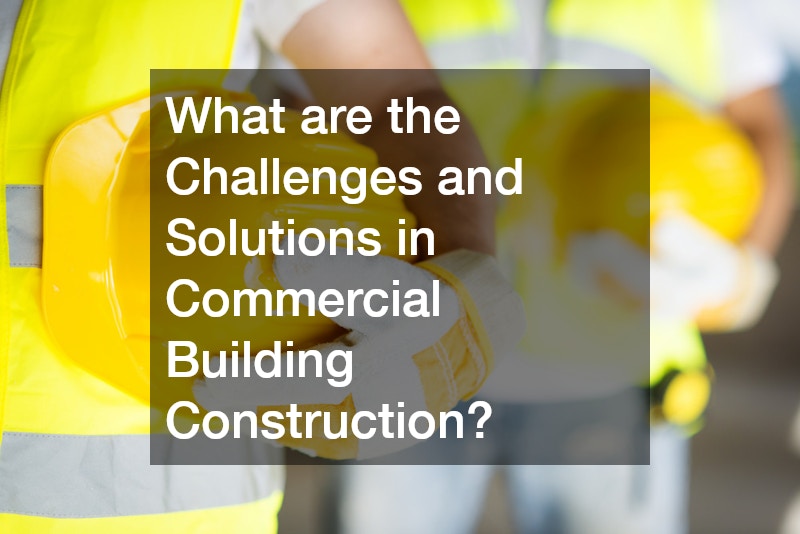
Even with careful planning, construction projects face challenges that must be managed proactively.
Overcoming Budget Overruns
Unexpected expenses are common in commercial construction. Contingency funds and careful monitoring of costs for HVAC systems, commercial metal fabrications, asphalt paving, and roofing installations help maintain budget discipline.
Addressing Construction Delays
Delays may arise due to weather, material shortages, or contractor availability. Coordinated scheduling, reliable suppliers, and using a certified site for construction reduce the risk of interruptions.
Mitigating Environmental Concerns
Environmental factors such as flooding, soil instability, or energy consumption can affect construction. Sustainable design, edpm roofing, water softener systems, and solar for businesses mitigate environmental impact while enhancing operational efficiency.
Handling Labor Shortages
Skilled labor shortages can slow progress. Developing strong relationships with reliable contractors, including commercial metal roofers, HVAC specialists, and plumbing contractors, ensures a consistent workforce.
Ensuring Long-Term Building Maintenance
Proper maintenance of HVAC systems, plumbing infrastructure, roofing, and asphalt surfaces preserves the commercial property’s value. Regular inspections and preventive repairs prevent costly issues and prolong the building’s lifespan.
Final Thoughts
Constructing a commercial building involves careful planning, thoughtful design, financial foresight, and strict adherence to legal and safety requirements. From selecting the right location to managing contractors and incorporating sustainable technologies like solar for businesses or water softener systems, every decision impacts the building’s success. By addressing key questions and considerations, owners can ensure their commercial property is safe, efficient, and well-equipped for long-term growth, durability, and functionality.

